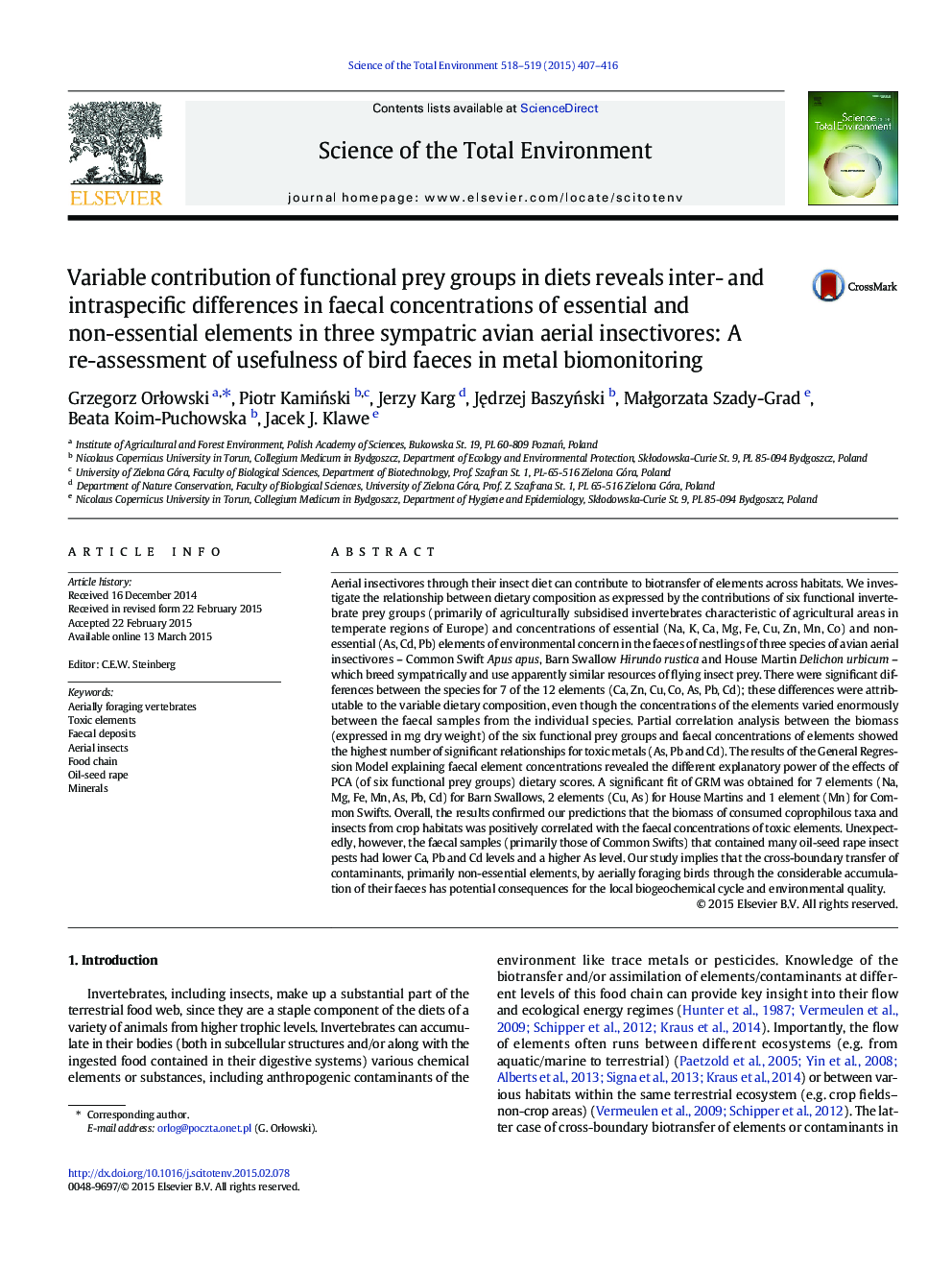| کد مقاله | کد نشریه | سال انتشار | مقاله انگلیسی | نسخه تمام متن |
|---|---|---|---|---|
| 6326883 | 1619761 | 2015 | 10 صفحه PDF | دانلود رایگان |
عنوان انگلیسی مقاله ISI
Variable contribution of functional prey groups in diets reveals inter- and intraspecific differences in faecal concentrations of essential and non-essential elements in three sympatric avian aerial insectivores: A re-assessment of usefulness of bird faec
ترجمه فارسی عنوان
سهم متغیر گروه های شغلی کاربردی در رژیم های غذایی اختلاف بین و درون غلظت در غلظت های مدفوع عناصر ضروری و غیر ضروری را در سه عفونت هوایی هواپیما نشان می دهد: ارزیابی مجدد مفید بودن فیش پرنده
دانلود مقاله + سفارش ترجمه
دانلود مقاله ISI انگلیسی
رایگان برای ایرانیان
کلمات کلیدی
مهره داران فوری عناصر سمی، ذخایر فاضلاب، حشرات هوایی، زنجیره ی غذایی، تجاوز به نفت، مواد معدنی،
موضوعات مرتبط
علوم زیستی و بیوفناوری
علوم محیط زیست
شیمی زیست محیطی
چکیده انگلیسی
Aerial insectivores through their insect diet can contribute to biotransfer of elements across habitats. We investigate the relationship between dietary composition as expressed by the contributions of six functional invertebrate prey groups (primarily of agriculturally subsidised invertebrates characteristic of agricultural areas in temperate regions of Europe) and concentrations of essential (Na, K, Ca, Mg, Fe, Cu, Zn, Mn, Co) and non-essential (As, Cd, Pb) elements of environmental concern in the faeces of nestlings of three species of avian aerial insectivores - Common Swift Apus apus, Barn Swallow Hirundo rustica and House Martin Delichon urbicum - which breed sympatrically and use apparently similar resources of flying insect prey. There were significant differences between the species for 7 of the 12 elements (Ca, Zn, Cu, Co, As, Pb, Cd); these differences were attributable to the variable dietary composition, even though the concentrations of the elements varied enormously between the faecal samples from the individual species. Partial correlation analysis between the biomass (expressed in mg dry weight) of the six functional prey groups and faecal concentrations of elements showed the highest number of significant relationships for toxic metals (As, Pb and Cd). The results of the General Regression Model explaining faecal element concentrations revealed the different explanatory power of the effects of PCA (of six functional prey groups) dietary scores. A significant fit of GRM was obtained for 7 elements (Na, Mg, Fe, Mn, As, Pb, Cd) for Barn Swallows, 2 elements (Cu, As) for House Martins and 1 element (Mn) for Common Swifts. Overall, the results confirmed our predictions that the biomass of consumed coprophilous taxa and insects from crop habitats was positively correlated with the faecal concentrations of toxic elements. Unexpectedly, however, the faecal samples (primarily those of Common Swifts) that contained many oil-seed rape insect pests had lower Ca, Pb and Cd levels and a higher As level. Our study implies that the cross-boundary transfer of contaminants, primarily non-essential elements, by aerially foraging birds through the considerable accumulation of their faeces has potential consequences for the local biogeochemical cycle and environmental quality.
ناشر
Database: Elsevier - ScienceDirect (ساینس دایرکت)
Journal: Science of The Total Environment - Volumes 518â519, 15 June 2015, Pages 407-416
Journal: Science of The Total Environment - Volumes 518â519, 15 June 2015, Pages 407-416
نویسندگان
Grzegorz OrÅowski, Piotr KamiÅski, Jerzy Karg, JÄdrzej BaszyÅski, MaÅgorzata Szady-Grad, Beata Koim-Puchowska, Jacek J. Klawe,
